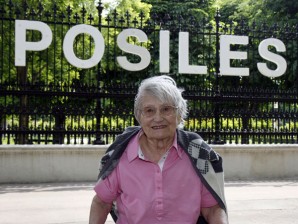
Edeltrud Posiles poses in front of her name that was attached on a fence in downtown Vienna, on Friday, May 13, 2011. 94-year old Posiles is the last one of 88 Austrians known to have saved Jews from the Holocaust who is still alive. She has hidden her Jewish fiance and his two brothers. They had fled to Prague after the Nazi annexation of Austria in 1938. But by 1942, that city too was in the hands of Hitler's henchmen. The three were told to pack essentials for deportation into a concentration camp. They wrote suicide letters to make authorities think they were dead _ and then did what no one thought any Jew would do, taking a night train straight to Vienna, back into the heartland of the Nazi Reich. (AP Photo/Ronald Zak)
NEW YORK— The signature under the typewritten words on yellowing sheets of nearly century-old paper is unmistakable: Adolf Hitler, with the last few scribbled letters drooping downward.
The date is 1919 and, decades before the Holocaust, the 30-year-old German soldier — born in Austria — penned what are believed to be Hitler’s first written comments calling for the annihilation of Jews.
Written on a German army typewriter, Hitler’s letter has long been known to scholars. It is considered significant because it demonstrates how early he was forming his anti-Semitic views.
The document was displayed Tuesday by the founder of a Jewish human rights organization that purchased what he says is the original letter last month.
Hitler “set the gold standard about man’s inhumanity to man,” said Rabbi Marvin Hier of the Simon Wiesenthal Center, named after the late Nazi hunter.
Three weeks ago, the Los Angeles-based organization purchased the original for $150,000 from Profiles in History, a dealer in Calabasas Hills, California, which acquired the document from another dealer, who in turn purchased it from a U.S. Army soldier named William F. Ziegler, according to the rabbi.
Ziegler is said to have found the four typed pages in a Nazi archive near Nuremberg, Germany, in the final months of World War II.
“The danger posed by Jewry for our people today finds expression in the undeniable aversion of wide sections of our people,” Hitler wrote in German. “The cause of this aversion … arises mostly from personal contact and from the personal impression that the individual Jew leaves — almost always an unfavorable one.”
In one section, Hitler said that a powerful government could curtail the so-called “Jewish threat” by denying their rights. But “its final aim, however, must be the uncompromising removal of the Jews altogether.”
At the time, Hitler was serving in the German army, and had taken to riling up the troops with his anti-Semitic rants. A superior officer urged Hitler to put his ideas on paper.
Known as the Gemlich letter, the document was certified as authentic in 1988 by handwriting expert Charles Hamilton, who had revealed the infamous “Hitler Diaries” to be forgeries.
Adolf Gemlich created propaganda for the German army. Hitler wrote the letter to him at the suggestion of Captain Ulrich Mayr, to help popularize the notion that someone was responsible for Germany’s defeat in World War I.
Hitler signed his letter, “Mit vorzueglicher Hochachtung,” meaning with deepest esteem.
This 1936 photo made by Gottfried Gilbert and provided by Alexandra Senfft shows her grandfather Hanns Elard Luding, left, and Hermann Goering, right, standing in front of Adolf Hitler as during a Nazi party convention in Nuremberg, Germany. Ludin, was Hitler's Slovakia envoy who was involved in the deportation of almost 70,000 Jews. After Ludin was hanged in 1947, his widow raised the children in the belief their father was "a good Nazi." In her book, "The Pain of Silence," she describes how a web of lies burdened her family over decades, especially her mother, who was 14 years old when her beloved father was hanged. (AP Photo/Gottfried Gilbert courtesy of Alexandra Senfft)
The center plans to put Hitler’s letter on view at its Museum of Tolerance in Los Angeles sometime in July.
“This is a seminal document that belongs to future generations,” said the rabbi.
Though it is insured for an undisclosed amount, “it’s priceless,” he added.